News and Past Events
Two Raffle Winners Announced at Opening Night for Cinema Italian Style
Thanks to our sponsors at Alaska Airlines, two lucky winners were each awarded a pair of roundtrip business class travel vouchers. As per the contest rules, the first drawing occured on November 12, 2025 just prior to the screening at SIFF Cinema Uptown of the festival's sold-out opening night film "Parental Leave". Alaska Airlines CEO Ben Minicucci was on hand to select the winning raffle ticket and presented the two business class vouchers to the raffle's first winner Rachel Solimeno.
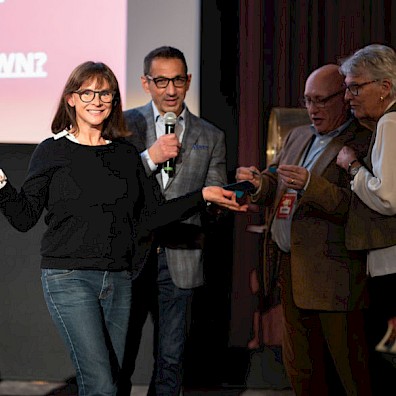
The 2nd drawing was also held on November 12th at 9:45PM during the festival's Opening Night Party at KEXP Gathering Space. Over 350 guests were on hand to see Massimo Carnelos, Consul General of Italy, draw the winning raffle ticket and present the second pair of business class travel vouchers to our second winner, festival attendee Valerie Berberoglu.
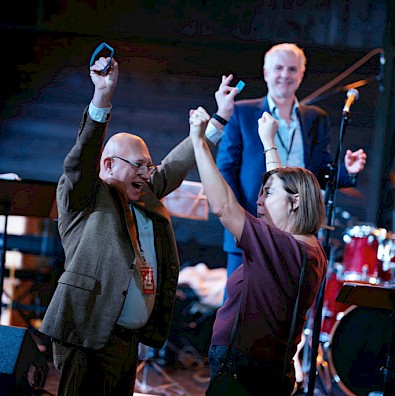
Proceeds of raffle tickets sales will be used to cover costs of this year's festival and help fund next year's event. Thank you to everyone who purchased raffle tickets for supporing the festival!
L'Italo Americano Feature: Perugia and Seattle: "Bonds Beyond Diplomacy"
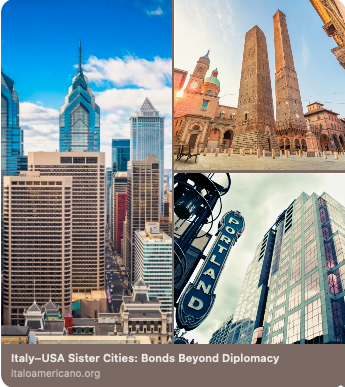 Seattle-Perugia Sister City in the news: In her article featured in the November 4th edition of L'Italo Americano, writer Guilia Franceschini beautifully captures the mission and spirit of our sister cities declaring "the pairings are often built on identity, memory, industry, or even shared personality" and how sister cities serve to provide "a map of how Italy and the United States see each other."
Seattle-Perugia Sister City in the news: In her article featured in the November 4th edition of L'Italo Americano, writer Guilia Franceschini beautifully captures the mission and spirit of our sister cities declaring "the pairings are often built on identity, memory, industry, or even shared personality" and how sister cities serve to provide "a map of how Italy and the United States see each other."
Thanks to our members in Seattle and Perugia who across more than three decades have work tirelessly to create meaningful bonds of collaboration and friendships.
Read the full article here: https://italoamericano.org/the-italy-usa-twin-city-matchups/
Living the Dream at Palazzo Gallenga
Written by 2025 October Scholar Victoria Olcott
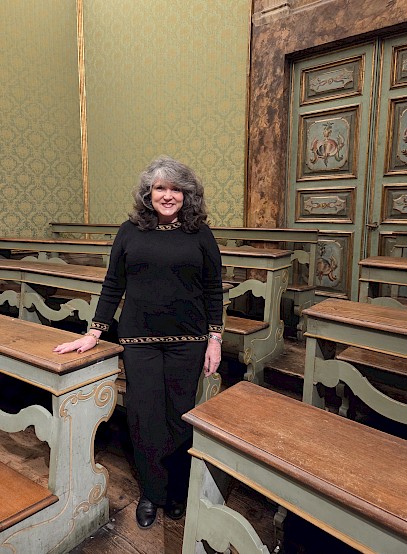
After eight years as a proud member of the Seattle-Perugia Sister City Association, and three scholarship applications later, I finally found myself walking through the grand doors of Palazzo Gallenga, home of the Università per Stranieri di Perugia. Studying Italian in this magnificent 18th-century palace felt like stepping inside a dream, one surrounded by art, history, and the melodic rhythm of the Italian language echoing through its marble halls.
Every morning, as sunlight filtered through the tall windows of my classroom, I felt amazed by the beauty around me. The frescoed ceilings, the soft hum of conversation in many accents, and the sense of shared purpose reminded me that learning Italian here was more than grammar and vocabulary, it was about connection, curiosity, and belonging.
My journey with Italian began long before I arrived in Perugia. As a child, I learned my first Italian words while traveling with my mother aboard Italian cruise ships during school vacations. Later, I started reading Topolino, the beloved Italian comic magazine, which opened a playful window into the language. Then came Oriana Fallaci’s books, whose powerful interviews and bold writing inspired me to follow the path of journalism and become the fourth generation of journalists in my family.
That fascination with words and storytelling, combined with my romantic nature and perseverance toward my goals, has guided me through every stage of my career and this unforgettable experience in Italy.
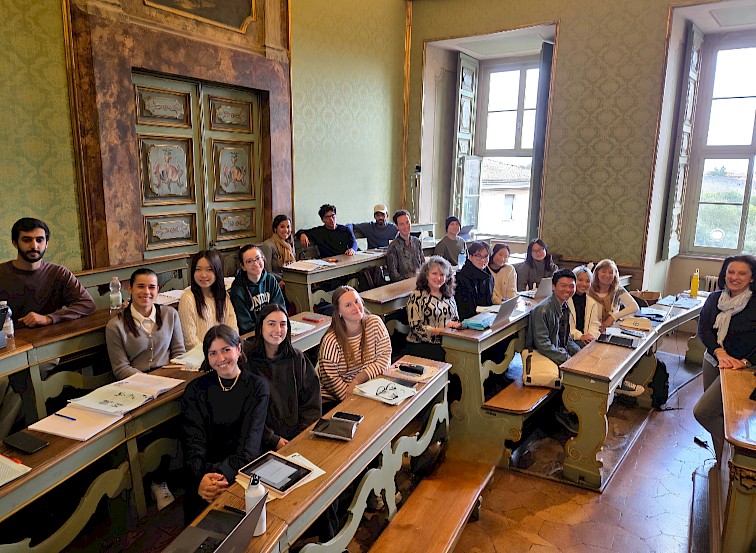
At Palazzo Gallenga, I was fortunate to study under Professors Marina, Valentina, and Maria Rita, whose guidance helped me enrich my vocabulary and improve my accent. Their enthusiasm made every class a joyful immersion into language and culture.
I was equally grateful for the kindness of Michele and Salvatore from technical support, who always answered my many questions about the palazzo’s history, and to Renato, who looked after the building’s security. He often greeted me with his gentle dog Rosetta, whom I happily took for walks in the park across the street after class. My sincere thanks also go to Manila, Cinzia, and Diego in the Segreteria, whose patience and directions made everything easier; and my forever gratitude to Valerio De Cesaris, UnistraPg Rettore, for his warm smile and continuous support for all our projects. Every corner of Palazzo Gallenga seemed alive with history and generosity, a place where learning extended far beyond the classroom.
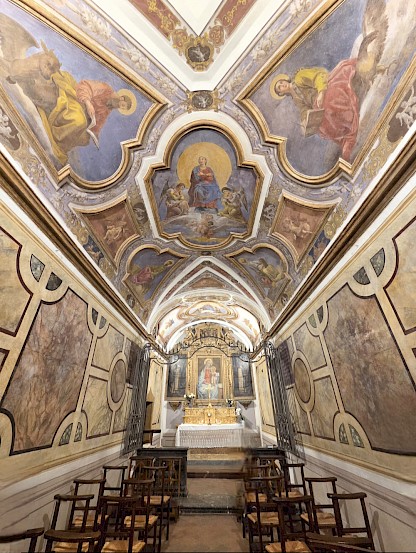
I spent hours walking along Corso Vannucci, Perugia’s elegant main street. I loved admiring the window displays of Italian fashion and jewelry, marveling at the timeless elegance and craftsmanship that distinguish Italy around the world. Each stroll became a celebration of beauty, design, and daily life. The city’s beautiful buildings, churches, and works of art were a constant feast for my eyes!
While others lined up for espresso and pizza, I preferred to reward myself with a creamy gelato or a piece of chocolate. In fact, I went to visit the Perugina chocolate factory two times, where I even took a class on how to make chocolate truffles, a truly delicious experience!
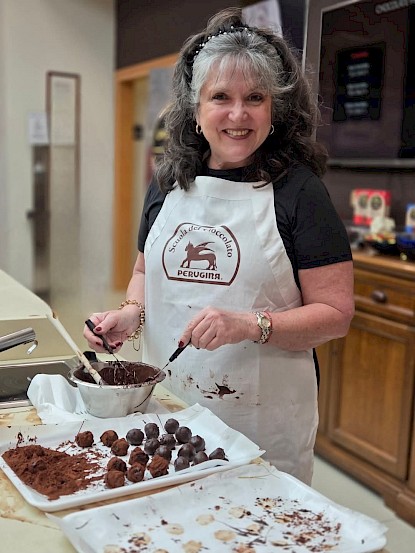
Living in Perugia meant discovering the extraordinary within the ordinary. The view from Giardini Carducci at sunset, the sound of street musicians near Piazza IV Novembre, and the familiar greetings from shopkeepers all became part of my rhythm. Each day felt like a small masterpiece of moments and emotions.
My weekends were devoted to exploring Umbria’s cultural treasures. My first journey took me to Cascia, where I visited the Basilica of Santa Rita, the saint of impossible causes. The atmosphere of peace and devotion there left a deep impression on me. Soon after, I traveled to Assisi to visit the Basilica of San Francesco, standing before Giotto’s frescoes that narrate a life of faith and humility. Finally, I explored Spoleto, whose medieval charm and scenic views captured my heart.
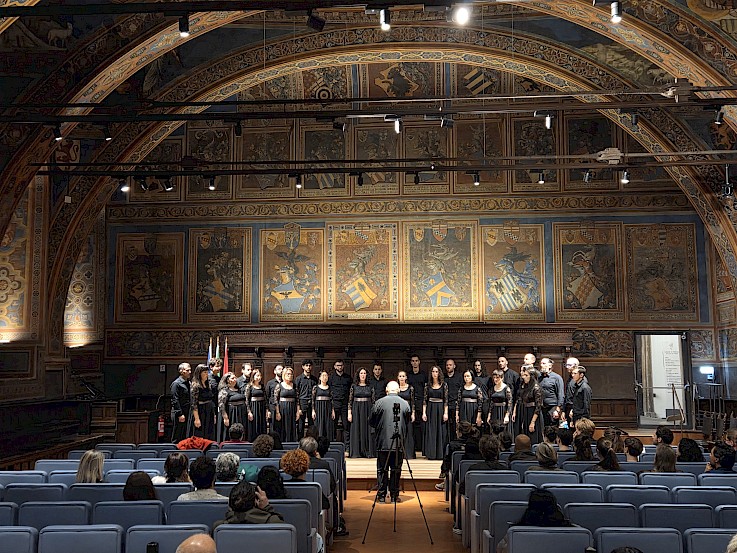
Back in Perugia, I delighted in attending choral concerts and art lectures at the Sala dei Notari, where the acoustics made every harmony soar. I was captivated by the extraordinary collection at the Galleria Nazionale dell’Umbria, filled with masterpieces that reflect centuries of artistic devotion. I also marveled at the stunning stained glass of the Laboratorio Moretti Caselli, the elegant Palazzo Baldeschi, and the magnificent Collegio del Cambio, adorned with Perugino’s timeless frescoes.
These experiences were more than sightseeing, they were emotional dialogues with history, art, faith and its people.
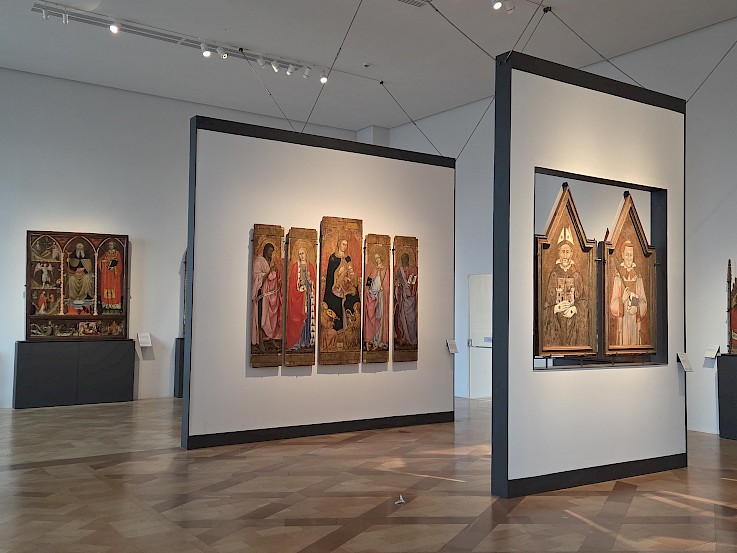
At Palazzo Gallenga, my professors made learning feel like a journey through Italy’s culture and identity. Classes were engaging and full of energy, we explored literature, history, and even Italian idioms that reveal how emotion is woven into the language. Each day brought a sense of accomplishment, whether from understanding a new grammar rule or finally being able to joke in Italian with classmates from every corner of the world, from Saudi Arabia, Austria, Poland, Hungary, Vietnam, Japan, to Argentina, Mexico and Ecuador.
Outside the classroom, I continued my role as Events and Communications Chair for SPSCA, staying connected to our Seattle community while living my Italian adventure. Together with our friends in Perugia, we organized a volunteer day at the “Sister Orca” sculpture in Pian di Massiano, cleaning, beautifying, and taking cheerful group photos to send back home. I also donated 20 books about Seattle’s history and photography to the city library, and shared ideas for future projects that could bring our two cities even closer. I even had the honor of delivering a short message of gratitude in Italian at Umbria Libri 2025 on behalf of SPSCA, a truly special moment!
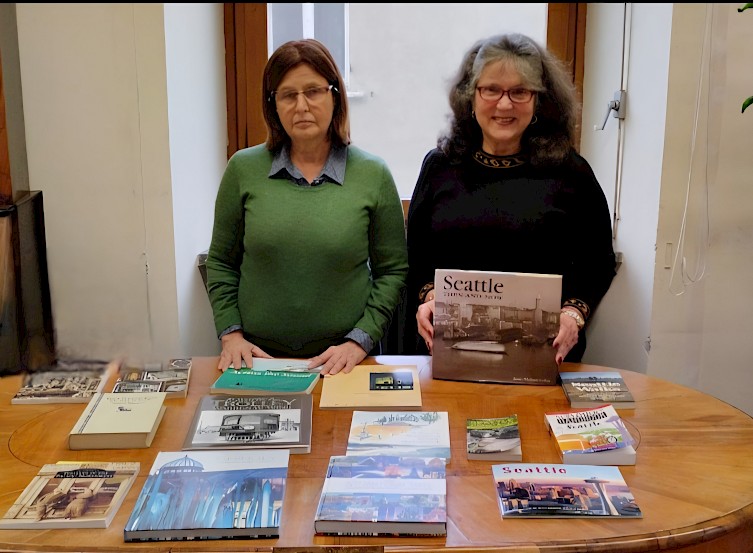
My time in Perugia was much more than an academic experience, it became a rediscovery of joy, curiosity, and inner harmony. Studying Italian in its homeland taught me to remember to appreciate what I have, to embrace life with gratitude, and to savor “la dolce vita,” the sweet art of living with grace and kindness.
This journey also reminded me why I have remained so deeply committed to the Seattle-Perugia Sister City Association all these years. The friendships formed through this partnership go beyond distance, they are bridges of empathy, generosity, and shared purpose. I felt this spirit every day, through simple acts of kindness, heartfelt laughter, and meaningful connections that renewed my belief in the beauty of giving one’s best to others.
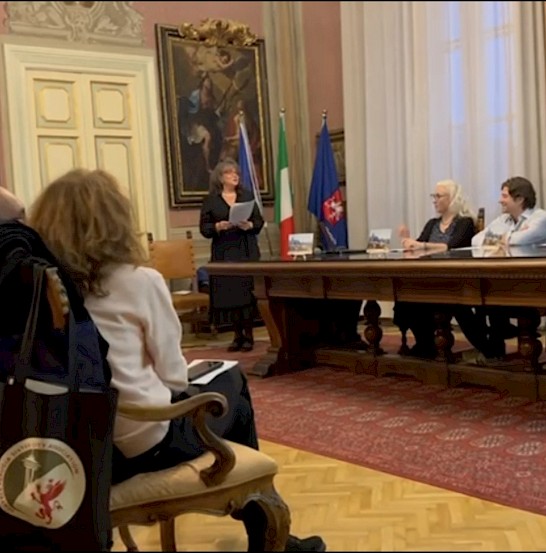
As my month in Perugia came to an end, I often lingered a little longer at Palazzo Gallenga, taking one last look at its grand staircase or at the light filling its courtyard and the beautiful view of the city and the valley from the terrace. What once felt like a dream had become a home.
I return to Seattle filled with gratitude to the Seattle-Perugia Sister City Association, to the donors, members, and volunteers: thank you for believing in the power of cultural exchange from people to people. To future scholarship recipients, I would say: come with curiosity, humility, patience, and an open heart. Let Perugia teach you, through its people, its art, and its quiet elegance, you will leave enriched. And perhaps most personally, this journey has inspired me to finally complete my long-dreamed book project, a compilation of my journalistic story born from passion, gratitude, and the beauty of human connection.
For me, Palazzo Gallenga will forever remain a symbol of perseverance and grace, a place where dreams, languages, and cultures from around the world intertwine in the most beautiful way! Grazie mille di cuore, Seattle Perugia Sister City Association!
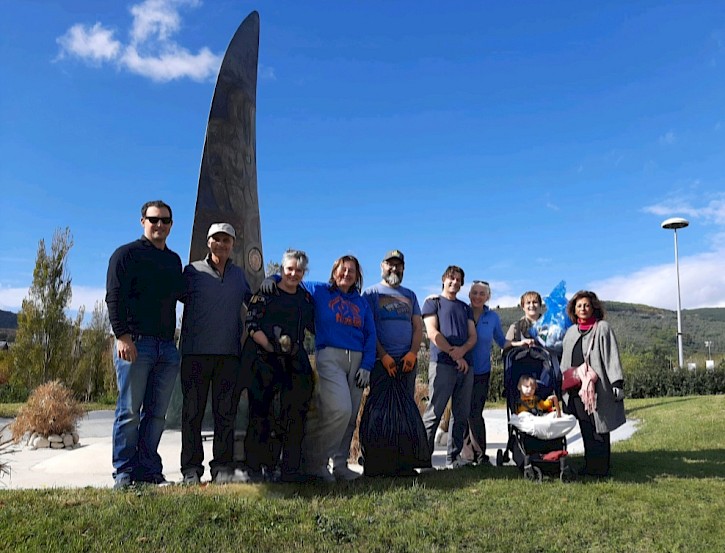
Piacere, Perugia!
Written by 2025 October Scholar Gina Cantara
What a rich and delightful experience studying in Perugia has been! I purposefully did not educate myself too much about the city, the region or the history of this area before I arrived. I wanted to immerse myself, be completely open and present to welcome this truly
once in a lifetime opportunity.
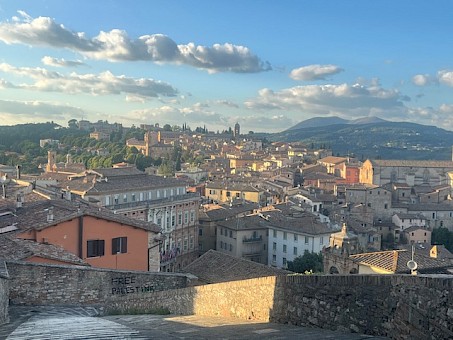
I entered the ancient Etruscan walls of Perugia in late September with a heart full of wonder and a tad bit of jet-lag. Here, I would spend one month studying Italian on a scholarship offered to me by the Seattle-Perugia Sister City Association. After studying Italian in Seattle for the past several years I decided this year was the time to get involved in more things Italian—both at home in the Pacific Northwest (PNW) and in Italy as my passion and interest in this culture continues to grow. When I became a member of the SCSPA, I had no idea that I would soon be a recipient of this esteemed annual scholarship. Each moment I gaze upon the green hills of Umbria, or sip my first morning cappuccino after waking to the sound of the nearby church bells, or amble through the narrow medieval streets of Perugia’s vibrant center, I stop and acknowledge my gratitude.
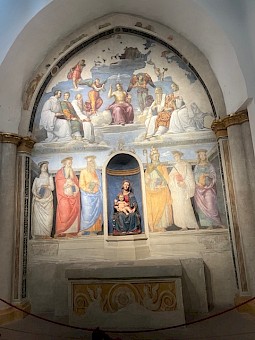
Certainly, most of my favorite things about Italy are similar to those of most stranieri (foreigners): the natural beauty of its varying landscapes, delicious food and wine, the layers of history, the art (frescos, sculptures, mosaics, music, opera, fashion...), the distinct architectural style of its cities, the cathedrals, and the warm and welcoming nature of its people. Without a doubt I hope to return again and again to this incredible country to enjoy all of these cultural facets as much as my life shall permit me to, however, my recent progress in this complicated yet poetic language has enlightened me. I now have a way to explain the core of my love for Italy.
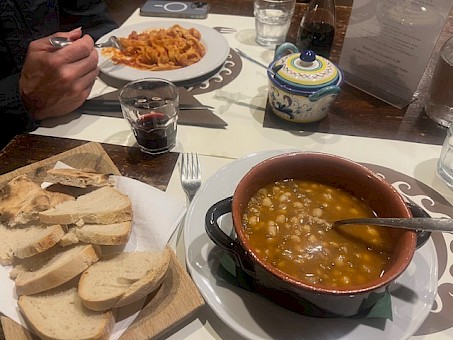
Unlike English, Italian has two words for “to know”. They are: sapere and conoscere. Understanding the distinction between these two words can be challenging at first, especially for those of us who descend from societies that value most the pursuits of information gathering and gaining technical skills, aka: “sapere.” We make a high score on a test, now we “know” the subject! We memorize facts and figures and now we “know” those things. To know things in this way is “sapere”, a cerebral conceptual type of knowledge. But what about knowing people? Places? Music? Art, food, a childhood bedtime story, a novel, a prayer, the sea, the mountains? Sure, we may learn facts and details about these things,
but “conoscere” is to feel or to sense or to be moved by something, to know something with your whole being. For example, you can memorize the recipe for tagliatelle with a wild truffle sauce (sapere), but only when you’ve tasted it, smelled it and savored it do you really know it. (conoscere). You can learn to play the cello by knowing how the strings work and reading a piece of music (sapere), but only when you’ve felt the vibrations in your body of a bow moving across the strings and when time stops even for a second as the haunting melancholy tones ring through your ear drums will you know the cello. (conoscere) Do you see where I am going with this?
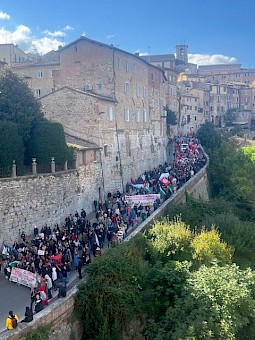
The distinction between these two ultra common words in the Italian language is to me the very reason I am drawn to this magnificent culture. The people live each day here with their mind, body, heart and soul. Italians are expressive, fiercely loving and always generously offering up their friendship, food and wine to those who want to “conoscere”. They value humanity and connection, striving to maintain parts of their culture long steeped in tradition and spirituality. These words, "Sapere" and "Conoscere," reflect a culture that believes there is room in our experiences for different ways of “knowing." Simply put—we can know with our brains or with our hearts. An old Native American proverb that mentions this distinction goes like this: The longest walk one will ever take is the one from the head to the heart. Both conceptual understanding and emotional experiences are important in order for a human to live a full and robust life.
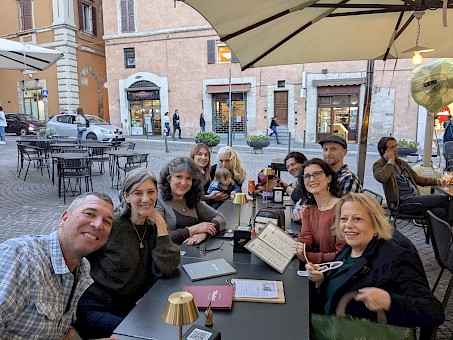
I feel so fortunate to have begun new friendships here with not only local residents, but students of different ages from all over the world. L’Universita di Stranieri is a melting pot of individuals, couples and families striving to learn the Italian language. During my time studying here, I never felt alone in my challenges or triumphs. Smiles, hugs, even some swearing sessions (in Italian, of course)- it was always—understood that we are all in this journey together. Thank you to the SPSCA, L’Universita di Stranieri, ALL of my teachers—here and in the US- all of my new friends and acquaintances, Percorso Italiano, and Perugia—è stato un piacere di conoscervi.
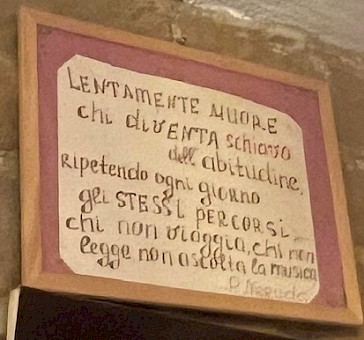
The translation: "Slowly dies he who becomes slave of habit, every day the steel path, he who does not travel, does not read, does not listen to music."
Like Drops of Water: From Social Action to Ancient History in Perugia!
Written by 2025 October Scholar Karin McCollough
This experience in Perugia is a respite from the storm of bad news I’d allowed myself to be inundated by. In the midst of global chaos, I have been trying to immerse myself in opportunities to understand these issues during my time here in Perugia. For example, October marks the end of the Perugia Social Film Festival (PerSo), which features films that explore the complexity of modern social problems. Before each film, you are met with a screen that loosely translates to “A truly special day is one in which there’s no war.”
This event is just one example of the abundance of messages that I am surrounded by, which include inclusivity, acceptance, acknowledgment of our common humanity, exhortations to do the right thing, and to respect our Earth. I have found these sentiments in classrooms, theaters, churches, streets, museums, theaters, parks, and monuments throughout the city. It seems to me that Perugians consider these values of utmost importance. As a result, I realized that if we want to change the world for the better, it is important that we nurture and spread those messages everywhere in daily life.
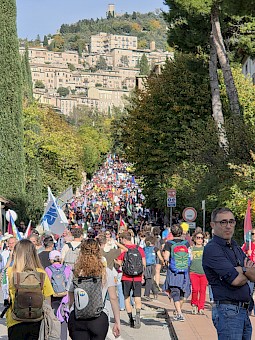
Recently, I happily participated in the annual 24 kilometer March for Peace & Fraternity from Perugia to Assisi. I walked along with over 200,000 people, specifically my 21 year old Chinese classmate (you can really get to know somebody walking the road together for 5 hours!). This march was founded by Perugino Aldo Capitini in 1961, who was influenced by Mahatma Gandhi's teachings of nonviolence.
Like my colleagues from Seattle, I'm so touched by this experience of using the Italian language to get to know people of all ages from all over the globe. Unlike my previous visits to Italy, I feel I have a purpose and that I am part of the community. I have enjoyed striking up conversations with the locals working in shops and even while waiting in long lines at the grocery store. For example, I'm such a regular at Gelateria Augusta that the cashier and I are on a first name basis. In fact, we have long chats daily about chocolate, our families, even world politics.
How often do you get to speak Italian with people across the world in their teens to their 80s? My classes in Italian language, culture, art, history, and film are blessedly small. I enjoy hearing the illuminating and inspiring stories and opinions of my fellow classmates, who come from China, South Korea, Iran, Bulgaria, Romania, England, Tajikistan, Morocco, Argentina, Peru, Chile, Mexico, Brazil, Turkey, Germany, Israel, Poland, Switzerland, the Netherlands. Here, by speaking Italian, we must think more, listen more, and—perhaps—say less. At the same time, it does tickle me to discover my sense of humor translates into Italian—every day I say something so off the wall in my classes that everyone laughs at my silliness. I adore my professors: they're open to answering any question, providing insights into the Italian way of life.
One of the highlights of my time here has been both participating and accompanying Voci dal Mondo, which is the choir open to all students of the university. The choir is under the loving, encouraging, and cheerful direction of Maestro Bustos. On October 30, 2025, there will be a free concert that features members of Voci dal Mondo and a visiting choir from Germany. The program includes a Latin American mass, a spiritual, an Indigenous North American piece, an Italian folk song, and a jazz piece.

Daily I'm moved to tears by the beauty here! In the city, I have enjoyed film festivals, guided walks and tours, an open mic night, a live jazz performance, small classical music ensembles, Beethoven symphonies in La Basilica di San Pietro (SRO!), as well as lectures about a variety of topics, including music, opera, cooking, recently published books, and cinema.
One of the highlights of my excursions has been a guided visit of Underground Perugia. The visit allows attendees to view remains of ancient Etruscan settlements, such as the astoundingly deep well that is built under what is now called Palazzo Sorbello. During this visit, I learned that the Etruscans built an acropolis (without mortar, mind you!) around and upon the highest point of a 500 meter high hill and covered it in “waterproof” travertine to minimize damage when the inevitable earthquakes strike. The travertine blocks are 3 meters deep & each level is set two centimeters deeper than the previous level. As a result, the earth in the center of these “walls” absorbs the quaking and the buildings above are not damaged by seismic activity. The Perugians I speak with are passionate about sharing the history of this town, which goes back hundreds of years. Through these different excursions, the perugians have shared with me their respect for the intelligence and engineering feats of the generations before them, while also expressing their hope for an even better future for the generations to come.
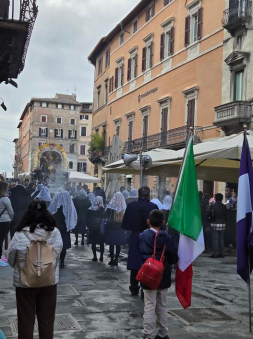
If you get the chance, I encourage you to get outside what you think is your “comfort zone” and come to Perugia and study at the Università per Stranieri. To that end, SPSCA’s scholarship program isn’t just an Italian language learning experience. It is also a chance to make a difference in the world through one interaction at a time. My recommendation for future scholars is to unplug, show up, be present, listen to others, be kind, be open, and share your own perspectives.
In times of trouble, we might wring our hands or hide our head in the sand thinking “I'm powerless” or “I want to pretend this isn't happening.” But, if we can just be patient and do what seems good no matter how tiny or insignificant we feel we are, I think we—like one drop of water at a time—will be making the world better for all. SPSCA & the l’Università per Stranieri di Perugia are wonderful organizations for doing that: I thank both of them for this opportunity to be a drop of water and be surrounded by all these other precious drops of water.
